Wistron MS2146BG Notebook Computer with WLAN User Manual AJC e
Wistron Corporation Notebook Computer with WLAN AJC e
Wistron >
Contents
Manual 1

Notebook Computer
User’s guide
AJC-e.book Page i Wednesday, September 3, 2003 1:48 PM
Changes may be made periodically to the information in this publication without obligation to notify any
person of such revision or changes. Such changes will be incorporated in new editions of this manual or
supplementary documents and publications. This company makes no representations or warranties, either
expressed or implied, with respect to the contents hereof and specifically disclaims the implied warranties of
merchantability or fitness for a particular purpose.
Record the model number, serial number, purchase date, and place of purchase information in the space
provided below. The serial number and model number are recorded on the label affixed to your computer.
All correspondence concerning your unit should include the serial number, model number, and purchase
information.
Model Number : __________________________________
Serial Number:____________________________________
Purchase Date: ___________________________________
Place of Purchase: ________________________________
Copyright © 2003
All Rights Reserved
Notebook Computer User’s guide
Original Issue: August 2003
Notebook Computer
All trademarks and registered trademarks are the properties of their respective companies.
AJC-e.book Page ii Wednesday, September 3, 2003 1:48 PM

Contents iii
Preface vii
Connecting the computer vii
Care and maintenance ix
1 Getting familiar with your computer 1
A tour of your computer 3
Top view 3
Front view 5
Left view 6
Right view 7
Rear view 7
Bottom view 9
Features 10
Display 12
Indicators 13
Keyboard 15
Special keys 15
Keyboard ergonomics 20
Touchpad 21
Launch keys 23
Storage 25
Hard disk 25
Optical drive 25
Connectivity options 28
Ethernet and LAN 28
Fax/data modem 28
Optional wireless communication 30
Fast infrared 31
Audio 32
AV control panel 33
Securing your computer 37
Security notch 37
Passwords 37
2 Operating on battery power 39
Battery pack 41
Battery pack characteristics 41
Installing and removing the battery pack 42
Charging the battery 43
Checking the battery level 44
Optimizing battery life 44
AJC-e.book Page iii Wednesday, September 3, 2003 1:48 PM
Contentsiv
Battery-low warning 45
Power management 45
Advanced Configuration and Power Interface 46
3 Peripherals and options 47
External monitor 49
Using simultaneous display 49
S-video 50
External keyboard 51
External pointing device 52
Printer 53
Audio devices 54
PC Card 55
PC Card slot 55
USB devices 57
IEEE 1394 devices 58
Miscellaneous options 59
Additional power packs 59
Key component upgrades 60
Memory upgrade 60
Hard disk upgrade 60
4 Moving with your computer 61
Disconnecting from the desktop 63
Moving around 63
Preparing the computer 63
What to bring to short meetings 63
What to bring to long meetings 63
Taking the computer home 63
Preparing the computer 64
What to bring with you 64
Special considerations 64
Setting up a home office 64
Traveling with the computer 65
Preparing the computer 65
What to bring with you 65
Special considerations 65
Traveling internationally with the computer 65
Preparing the computer 65
What to bring with you 66
Special considerations 66
AJC-e.book Page iv Wednesday, September 3, 2003 1:48 PM
v
5 Software 67
System software 69
Launch Manager 70
BIOS Utility 71
Security 72
Exit 75
6 Troubleshooting 77
Frequently-asked questions 79
Error messages 82
A Specifications 87
B Notices 93
Index 101
AJC-e.book Page v Wednesday, September 3, 2003 1:48 PM
Contentsvi
AJC-e.book Page vi Wednesday, September 3, 2003 1:48 PM
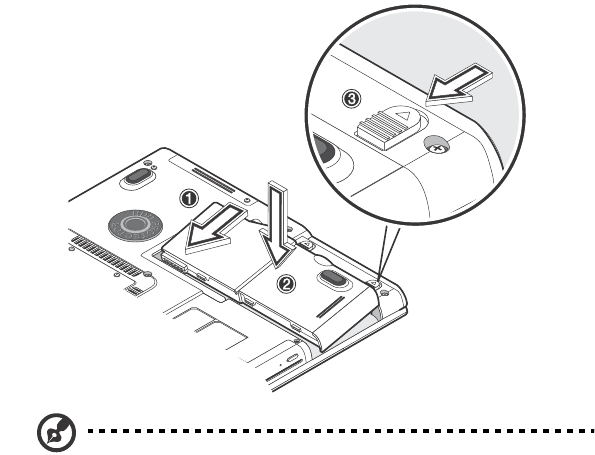
vii
Preface
This notebook computer incorporates such features as CardBus, internal pointing
device, IEEE 1394, and Universal Serial Bus in an portable package.
This manual should answer most of the questions you have about the day-to-day
operation of your notebook computer.
You should also take advantage of the online help files that are available with
almost all of the programs shipped with your computer.
We hope you enjoy your notebook computer. With proper care, your computer
will provide you with years of productive service.
Connecting the computer
Connecting the computer is as easy as 1-2-3.
1. Insert the battery at an angle (1); press gently on the battery (2) until it click
into place. Then slide the lock/unlock latch into the lock position (3).
Note: When using a battery pack for the first time, fully recharge the battery,
then disconnect the adapter to use up the battery before recharging again.
Perform this action twice to condition the battery pack.
AJC-e.book Page vii Wednesday, September 3, 2003 1:48 PM
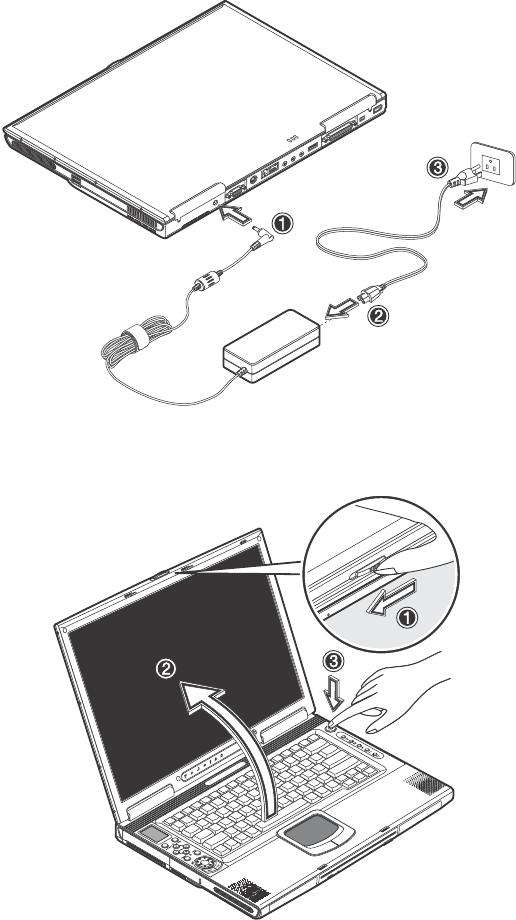
viii
2. Connect one end of the AC adapter to the DC-in port on the computer’s rear
panel and the other end to a properly grounded power outlet.
3. Slide the display cover latch to the left (1) to open the display (2). Press the
power switch (3) to turn on the power. The POST (power-on self-test) routine
executes and Windows begins loading.
AJC-e.book Page viii Wednesday, September 3, 2003 1:48 PM

ix
Note: To turn off the power, we recommend that you use the Windows Turn
Off command to shut down the computer. If you are unable to shut down
your computer normally, press and hold the power switch for more than four
seconds to turn off the computer. If you turn off the computer and want to
turn it on again, wait at least two seconds before powering up.
Care and maintenance
Taking care of your computer
Your computer will serve you well if you take care of it.
• Do not expose the computer to direct sunlight. Do not place it near sources of
heat, such as a radiator.
• Do not expose the computer to temperatures below 0ºC (32ºF) or above 50ºC
(122ºF).
• Do not subject the computer to magnetic fields.
• Do not expose the computer to rain or moisture.
• Do not spill water or any liquid on the computer.
• Do not subject the computer to heavy shock and vibration.
• Do not expose the computer to dust and dirt.
• Never place objects on top of the computer to avoid damaging the computer.
• Never place the computer on uneven surfaces.
Taking care of your AC adapter
Here are some ways to take care of your AC adapter:
• Do not connect the adapter to any other device.
• Do not step on the power cord or place heavy objects on top of it. Carefully
route the power cord and any cables away from all potential traffic.
• When unplugging the power cord, do not pull on the cord itself but pull on the
plug.
• The total ampere ratings of the equipment plugged in should not exceed the
ampere rating of the cord if you are using an extension cord. Also, the total
current rating of all equipment plugged into a single wall outlet should not
exceed the fuse rating.
AJC-e.book Page ix Wednesday, September 3, 2003 1:48 PM
x
Taking care of your battery pack
Here are some ways to take care of your battery pack:
• Use only batteries of the same kind as replacements. Turn the power off
before removing or replacing batteries.
• Do not tamper with batteries. Keep them away from children.
• Dispose of used batteries according to local regulations. Recycle if at all
possible.
Cleaning and servicing
When cleaning the computer, follow these steps:
1. Power off the computer and remove the battery pack.
2. Disconnect the AC adapter.
3. Use a soft cloth moistened with water. Do not use liquid or aerosol cleaners.
Contact your dealer or see your service technician if any of the following occurs:
• The computer has been dropped or the body has been damaged.
• Liquid has been spilled into the product.
• The computer does not operate normally.
AJC-e.book Page x Wednesday, September 3, 2003 1:48 PM

1 Getting familiar with
your computer
AJC-e.book Page 1 Wednesday, September 3, 2003 1:48 PM

This computer combines high-performance, versatility,
power management features and multimedia capabilities with
a unique style and ergonomic design. Work with unmatched
productivity and reliability with your new power computing
partner.
This chapter gives an in-depth "tour" of the computer’s many
features.
AJC-e.book Page 2 Wednesday, September 3, 2003 1:48 PM
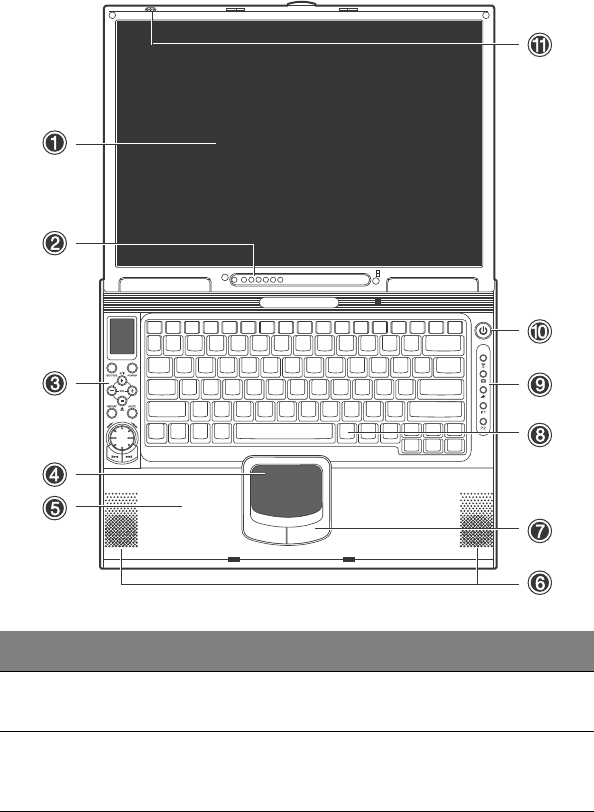
3
A tour of your computer
Let us show you around your new notebook computer.
Top view
#Item Description
1 Display screen Also called LCD (liquid-crystal display), displays
computer output.
2 Status indicator LEDS (light-emitting diodes) that turn on and off to
show the status of the computer and its functions and
components.
AJC-e.book Page 3 Wednesday, September 3, 2003 1:48 PM
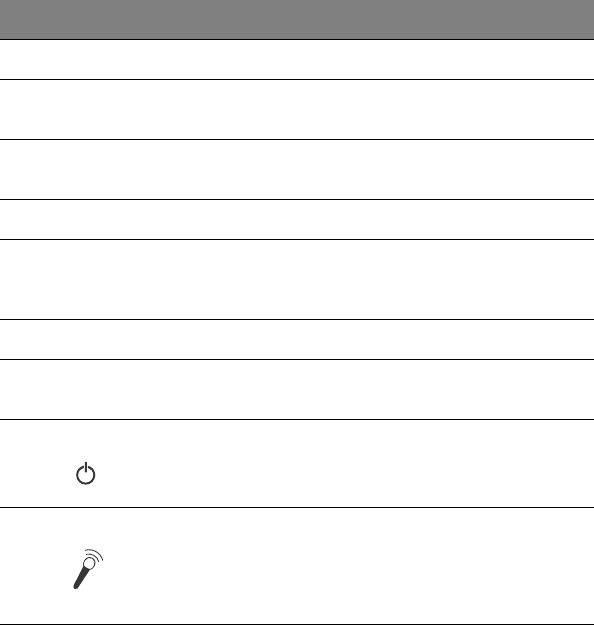
1 Getting familiar with your computer4
3 AV control panel Control buttons for playing audio/video media.
4 Touchpad Touch-sensitive pointing device which functions like a
computer mouse.
5 Palmrest Comfortable support area for your hands when you use
the computer.
6 Speakers Outputs sound.
7 Click buttons (left,
center and right)
The left and right buttons function like the left and
right mouse buttons; the center button serves as a 4-
way scroll button.
8 Keyboard Inputs data into your computer.
9 Launch keys Buttons for launching frequently used programs. See
“Launch keys” on page 23 for more details.
10 Power button Turns on the computer power.
11 Microphone Inputs sounds and voices into your computer.
# Item Description
AJC-e.book Page 4 Wednesday, September 3, 2003 1:48 PM
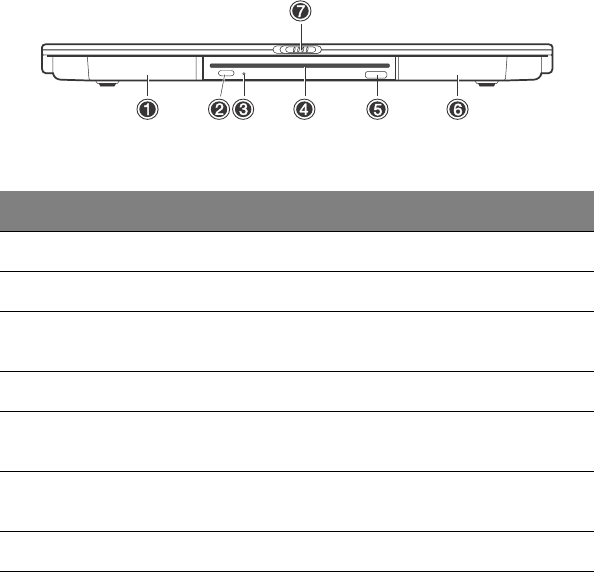
5
Front view
#Item Description
1 Battery bay Houses the computer’s battery pack.
2 Eject button Ejects the CD/DVD disk.
3 LED indicator Lights up when the DVD/CD-RW combo drive is
active.
4 Drive slot Slot for inserting a CD or DVD.
5 Infrared port Interfaces with infrared devices (e.g., infrared printer,
IR-aware computer).
6 Expansion module Module for optional second hard disk or optional
subwoofer.
7 Display cover latch Unlatch to open the LCD display.
AJC-e.book Page 5 Wednesday, September 3, 2003 1:48 PM
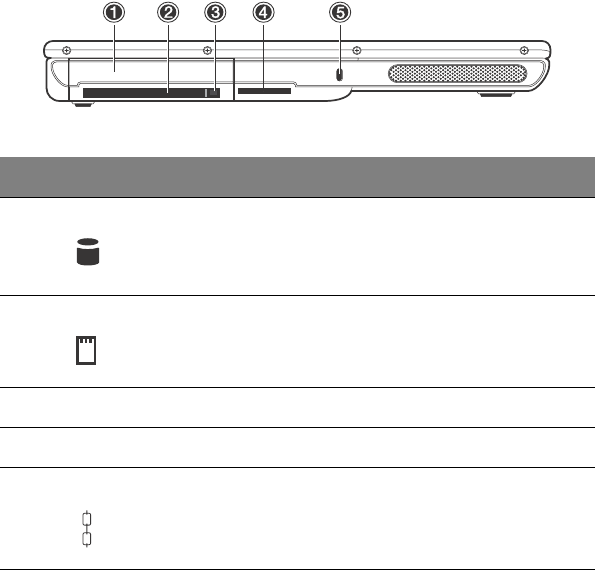
1 Getting familiar with your computer6
Left view
# Item Description
1 Hard disk Bay Houses the computer’s hard disk.
2PC Card slot Accepts one Type II 16-bit PC Card or 32-bit CardBus
PC Card with ZV support.
3 PC Card eject button Ejects the PC Card from its slot.
4 SD slot Accepts Secured Digital (SD) memory card.
5 Security keylock Connects to a Kensington-compatible computer
security lock.
AJC-e.book Page 6 Wednesday, September 3, 2003 1:48 PM
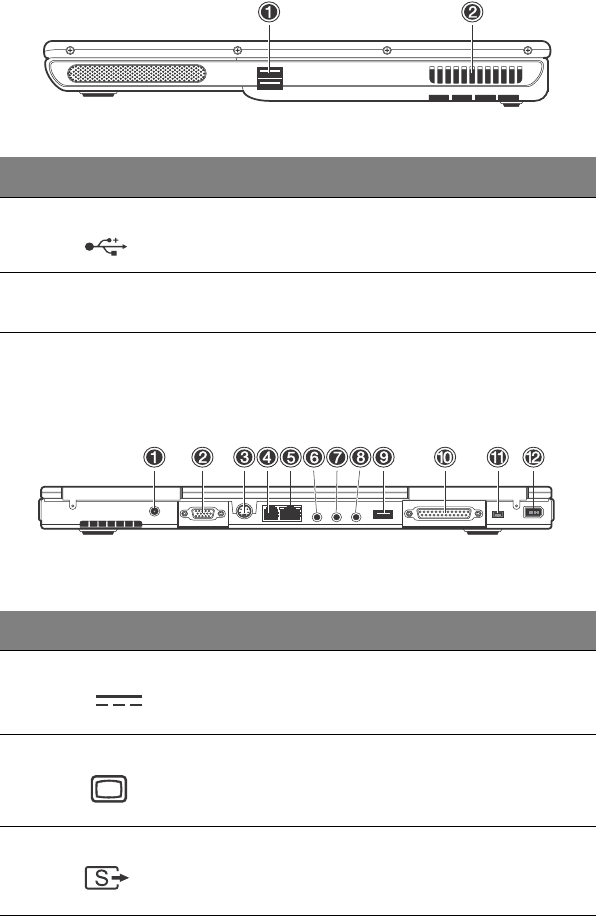
7
Right view
Rear view
#Item Description
1 USB ports Connect to a USB devices (e.g., USB mouse).
2 Fan slots Keep the computer cool. Do not cover these slots to
prevent the computer from overheating.
# Item Description
1 DC-in jack Connects to an AC adapter.
2 External monitor port Connects to a display monitor (up to 2048x1536
resolution).
3 S-video port Connects to a television or display device with S-
video input.
AJC-e.book Page 7 Wednesday, September 3, 2003 1:48 PM
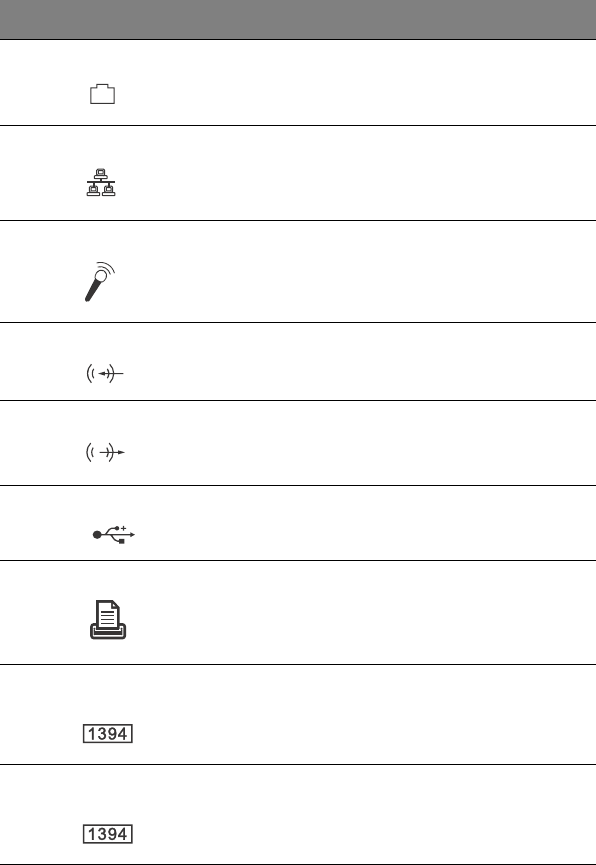
1 Getting familiar with your computer8
4 Modem jack Connects a phone line (only for models with an
internal fax/data modem).
5 Network jack Connects to an Ethernet 10/100-based network.
6 Microphone-in jack Connects to a microphone; supports S/PDIF (Sony/
Philips Digital Interface) digital input
7 Line-in jack Accepts audio line-in devices (e.g., audio CD player,
stereo walkman).
8 S/PDIF line-out jack Connects to S/PDIF audio line-out devices (e.g.,
speakers, headphones).
9 USB port Connect to a USB devices (e.g., USB digital
camera).
10 Parallel port Connects to a parallel device (e.g., parallel printer).
11 IEEE 1394 port (4-
pin)
Connects to a IEEE 1394-compatible (4-pin) device
(e.g., digital video camera).
12 IEEE 1394 port (6-
pin)
Connects to a IEEE 1394-compatible (6-pin) device
(e.g., digital video camera).
#Item Description
AJC-e.book Page 8 Wednesday, September 3, 2003 1:48 PM
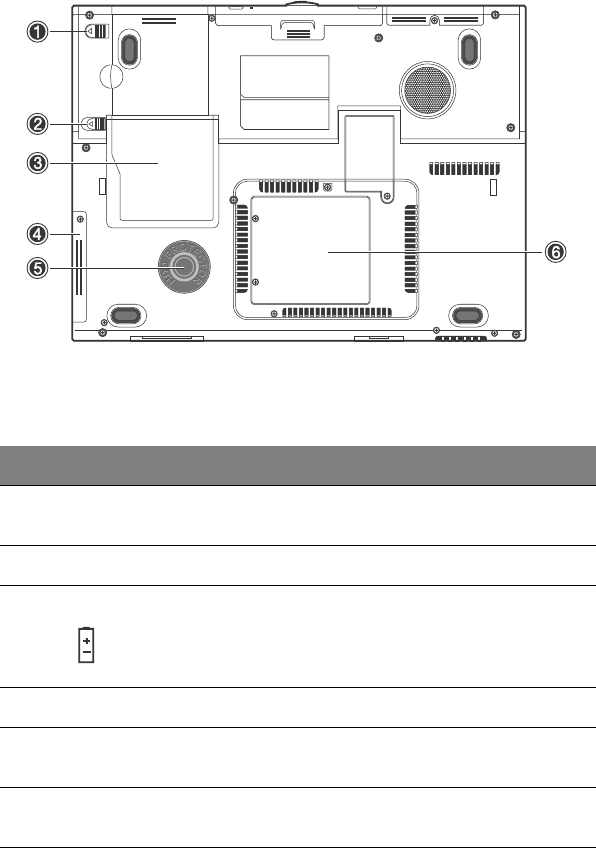
9
Bottom view
#Item Description
1 Battery lock/unlock
latch
Locks/unlocks the battery pack.
2 Battery release latch Unlatches the battery to remove the battery pack.
3 Battery bay Houses the computer’s battery pack.
4 Hard disk bay Houses the computer’s hard disk.
5 Hard disk protector Protects the hard disk from accidental bumps and
vibrations.
6 Memory
compartment
Houses the computer’s main memory.
AJC-e.book Page 9 Wednesday, September 3, 2003 1:48 PM
1 Getting familiar with your computer10
Features
This computer was designed with the user in mind. Here are just a few of its many
features:
Performance
• Mobile Intel® Pentium® 4 Processor - M with Enhanced Intel® SpeedStep™
technology
• 1 MB (1024K) on-die L2 cache
• 15.4” 16:10 SXGA (1280x800) widescreen TFT LCD panel
• ATI® Mobility™ Radeon™ 9600 high-performance graphics chipset with
64MB frame buffer
• Onboard memory upgradable to 2048 MB with 2 DDR-266/333 SoDIMM
• High-capacity, Enhanced-IDE hard disk
• Lithium Ion battery pack
• Power management system
• Dual display capability
• Simultaneous LCD and CRT display
• LCD panel supports resolution up to 2048x1536
• VGA monitor supports resolution up to 2048x1536
• Embedded TV encoder supports resolution up to 1024x768
Multimedia
• AV control panel
• Playback MP3 through SD, HDD or Audio CD with system off
• AC’97 2.2 compliant stereo audio
• S/PDIF line-out jack
• Enhanced audio system with 2 speakers and an optional subwoofer
• Built-in microphone
• Slot-loading DVD/CD-RW combo drive
• S-video output port
Connectivity
• High-speed fax/data software modem
AJC-e.book Page 10 Wednesday, September 3, 2003 1:48 PM
11
• Onboard PCI 10/100 Mbps LAN support
• Fast infrared wireless communication
• USB (Universal Serial Bus) ports (2.0)
• 2 IEEE 1394 ports (one mini port and one regular port)
• Optional 802.11b/g wireless LAN
Human-centric design and ergonomics
• Sleek, smooth and stylish design
• Full-sized keyboard
• Ergonomically-centered touchpad pointing device
• Launch keys
Expansion
• Upgradeable memory and hard disk
• Second hard disk module
• Secure Digital (SD) slot
AJC-e.book Page 11 Wednesday, September 3, 2003 1:48 PM

1 Getting familiar with your computer12
Display
The graphics display offers excellent viewing, display quality and desktop-
performance graphics. The computer supports a widescreen Thin-Film Transistor
(TFT) liquid crystal display (LCD) displaying up to 16.7 million colors at
1280x800 Super eXtended Graphics Array (SXGA) resolution.
Simultaneous display
The computer’s crisp display and multimedia capabilities are great for giving
presentations. If you prefer, you can also connect an external monitor when giving
presentations. This computer supports simultaneous LCD and CRT display.
Simultaneous display allows you to control the presentation from your computer
and at the same time face your audience. You can also connect other output
display devices such as LCD projection panels for large-audience presentations.
Power management
The power management system incorporates an "automatic LCD dim" feature that
automatically dims the LCD when the computer is powered by a battery pack to
conserve battery power. See “Power management” on page 45 for more
information on power management features.
Opening and closing the display
To open the display, slide the display cover latch to the left and lift up the cover,
then tilt it to a comfortable viewing position. See “Connecting the computer” on
page vii. The computer employs a microswitch that turns off the display (e.g.,
enters standby mode) to conserve power when you close the display cover, and
turns it back on when you open the display cover.
Note: If an external monitor is connected, the computer turns off the display
(but does not enter standby mode) when you close the display cover.
To close the display cover, fold it down gently until the display cover latch clicks
into place.
Caution: To avoid damaging the display, do not slam it when you close it.
Also, do not place any object on top of the computer when the display is
closed.
AJC-e.book Page 12 Wednesday, September 3, 2003 1:48 PM
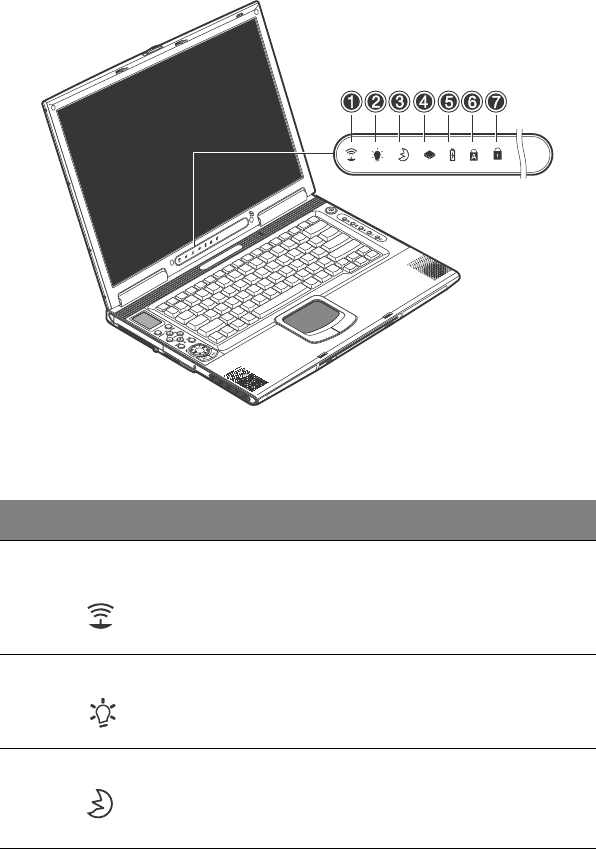
13
Indicators
The computer has seven easy-to-read status indicators (LEDs) under the display
screen.
The Power and Standby indicators are visible even when you close the display
cover so you can see the status of the computer while the cover is closed.
#Function Description
1Wireless
communication
Lights when the Bluetooth/Wireless LAN (optional)
capabilities are enabled.
2 Power Lights when the computer is on.
Blinks when a battery-low condition occurs.
3 Standby Blinks when computer enters Hibernation mode.
AJC-e.book Page 13 Wednesday, September 3, 2003 1:48 PM
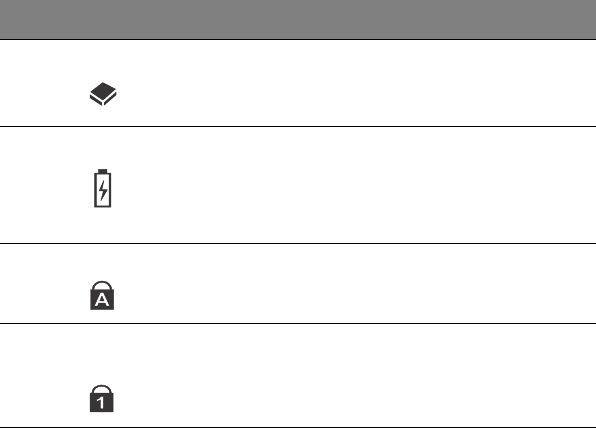
1 Getting familiar with your computer14
4 Media activity Lights when the hard disk, or CD or DVD drive is
active.
5 Battery charge Lights when the battery is being charged.
6 Caps lock Lights when Caps Lock is activated.
7Num lock
(Fn-F11)
Lights when Numeric Lock is activated.
#Function Description
AJC-e.book Page 14 Wednesday, September 3, 2003 1:48 PM
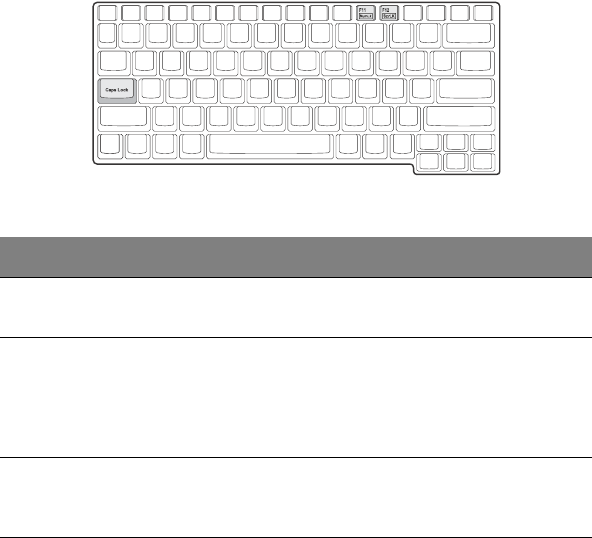
15
Keyboard
The keyboard has full-sized keys with an embedded keypad, separate cursor keys,
two Windows keys and twelve function keys.
Special keys
Lock keys
The keyboard has three lock keys which you can toggle on and off.
Lock Key Description
Caps Lock When Caps Lock is on, all alphabetic characters typed are in
uppercase.
Num Lock (Fn-
F11)
When Num Lock is on, the embedded keypad is in numeric mode.
The keys function as a calculator (complete with the arithmetic
operators +, -, *, and /). Use this mode when you need to do a lot of
numeric data entry. A better solution would be to connect an
external keypad. See “External keyboard” on page 51.
Scroll Lock
(Fn-F12)
When Scroll Lock is on, the screen moves one line up or down when
you press ↑ or ↓ respectively. Scroll Lock does not work with some
applications.
AJC-e.book Page 15 Wednesday, September 3, 2003 1:48 PM
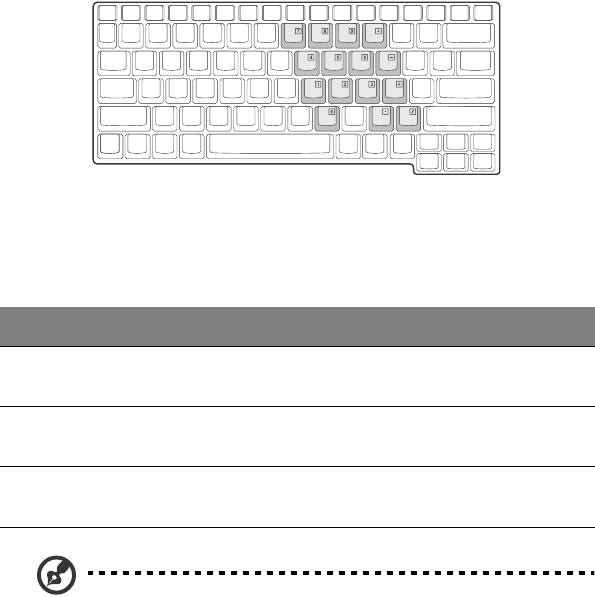
1 Getting familiar with your computer16
Embedded numeric keypad
The embedded numeric keypad functions like a desktop numeric keypad. It is
indicated by small characters located on the upper right corner of the keycaps. To
simplify the keyboard legend, cursor-control key symbols are not printed on the
keys.
Note: If an external keyboard or keypad is connected to the computer, the
numlock feature automatically shifts from the internal keyboard to the
external keyboard or keypad.
Desired Access Num Lock On Num Lock Off
Number keys on
embedded keypad
Type numbers in a normal
manner.
Cursor-control keys on
embedded keypad
Hold Shift while using cursor-
control keys.
Hold Fn while using
cursor-control keys.
Main keyboard keys Hold Fn while typing letters on
embedded keypad.
Type the letters in a
normal manner.
AJC-e.book Page 16 Wednesday, September 3, 2003 1:48 PM
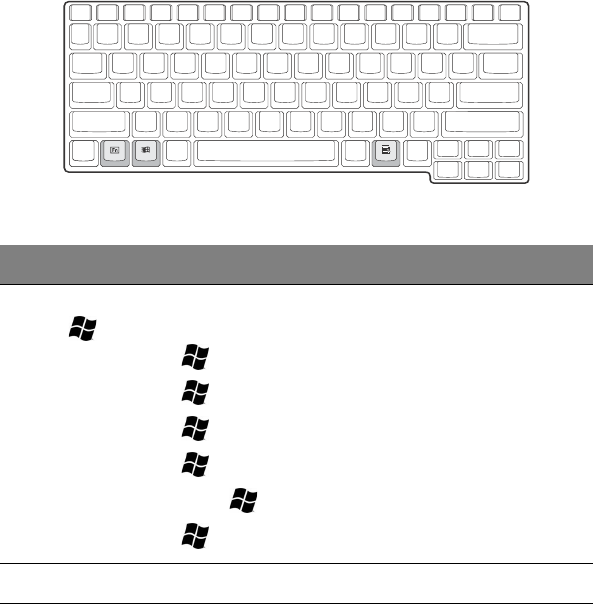
17
Windows keys
The keyboard has two keys that perform Windows-specific functions.
Key Description
Windows logo key Start button. Combinations with this key perform special
functions. Below are a few examples:
+ Tab (Activates next Taskbar button)
+ E (Explores My Computer)
+ F (Finds Document)
+ M (Minimizes All)
Shift + + M (Undoes Minimize All)
+ R (Displays Run dialog box)
Application key Opens the application’s context menu (same as right-click).
AJC-e.book Page 17 Wednesday, September 3, 2003 1:48 PM
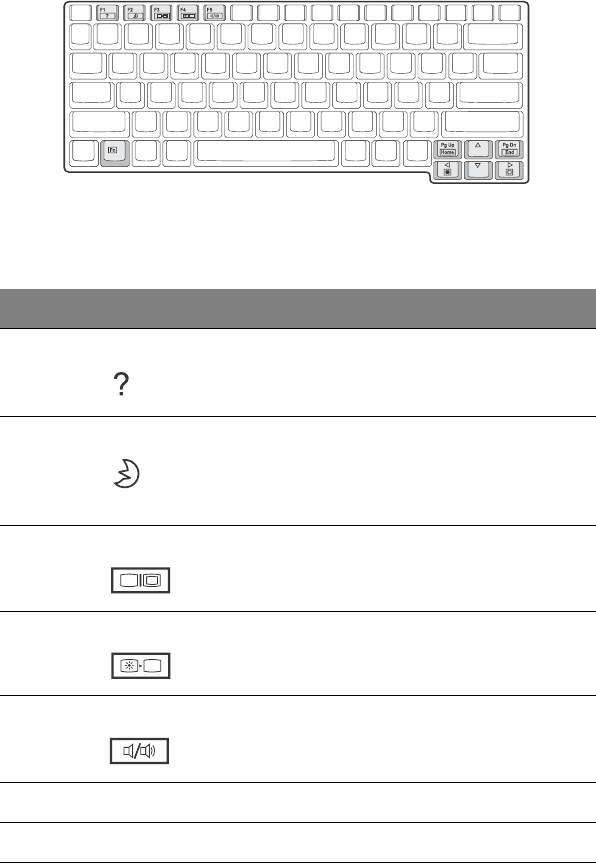
1 Getting familiar with your computer18
Hotkeys
The computer employs hotkeys or key combinations to access most of the
computer’s controls like screen contrast and brightness, volume output and the
BIOS setup utility.
HotKey Function Description
Fn-F1 Hotkey help Displays a list of the hotkeys and their functions.
Fn-F2 Sleep Puts the computer in Sleep mode, which can be
defined via the advanced section of the Power
Management Properties in the Windows Control
Panel.
Fn-F3 Display toggle Switches display output between the display
screen, external monitor (if connected) and both
the display screen and external monitor.
Fn-F4 Screen blank Turns the display screen backlight off to save
power. Press any key to return.
Fn-F5 Speaker on/off Turns the speakers on and off; mutes the sound.
Fn-PgUp Home Functions as the “Home” key.
Fn-PgDn End Functions as the “End” key.
AJC-e.book Page 18 Wednesday, September 3, 2003 1:48 PM
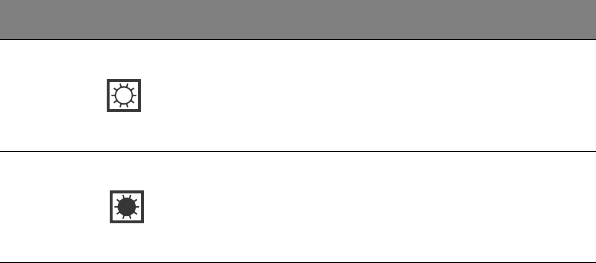
19
Activating hotkeys
When activating hotkeys, press and hold the Fn key before pressing the other key
in the hotkey combination.
Fn-→Brightness up Increases the screen brightness.
Fn-←Brightness down Decreases the screen brightness.
HotKey Function Description
AJC-e.book Page 19 Wednesday, September 3, 2003 1:48 PM
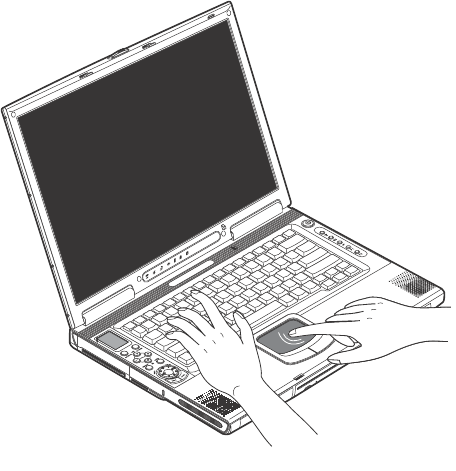
1 Getting familiar with your computer20
Keyboard ergonomics
Located below the keyboard, the wide and curved palm rest is ergonomically
designed to provide you with a very comfortable place to rest your hands while
you type.
AJC-e.book Page 20 Wednesday, September 3, 2003 1:48 PM
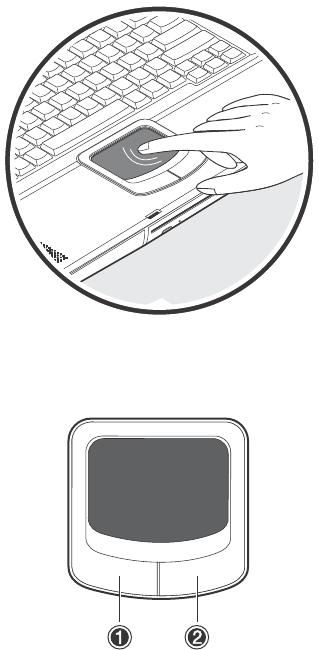
21
Touchpad
The built-in touchpad is a pointing device that senses movement on its surface.
This means the cursor responds as you move your finger on the surface of the
touchpad. The central location on the palm rest provides optimum comfort and
support.
Touchpad basics
The following teaches you how to use the touchpad:
• Move your finger across the touchpad to move the cursor.
• Press the left (1) and right (2) buttons located on the edge of the touchpad to
do selection and execution functions. These two buttons are similar to the left
and right buttons on a mouse. Tapping on the touchpad produces similar
results.
AJC-e.book Page 21 Wednesday, September 3, 2003 1:48 PM
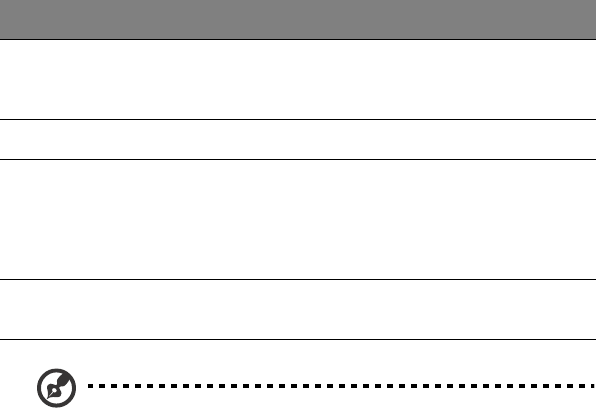
1 Getting familiar with your computer22
Note: Keep your fingers dry and clean when using the touchpad. Also keep
the touchpad dry and clean. The touchpad is sensitive to finger movements.
Hence, the lighter the touch, the better the response. Tapping too hard will
not increase the touchpad’s responsiveness.
Function Left Button Right Button Tap
Execute Click twice
quickly.
Tap twice (at the same speed as
double-clicking the mouse
button).
Select Click once. Tap once.
Drag Click and hold,
then use finger
to drag the
cursor on the
touchpad.
Tap twice (at the same speed as
double-clicking the mouse
button) and hold finger to the
touchpad on the second tap to
drag the cursor.
Access
context menu
Click once.
AJC-e.book Page 22 Wednesday, September 3, 2003 1:48 PM
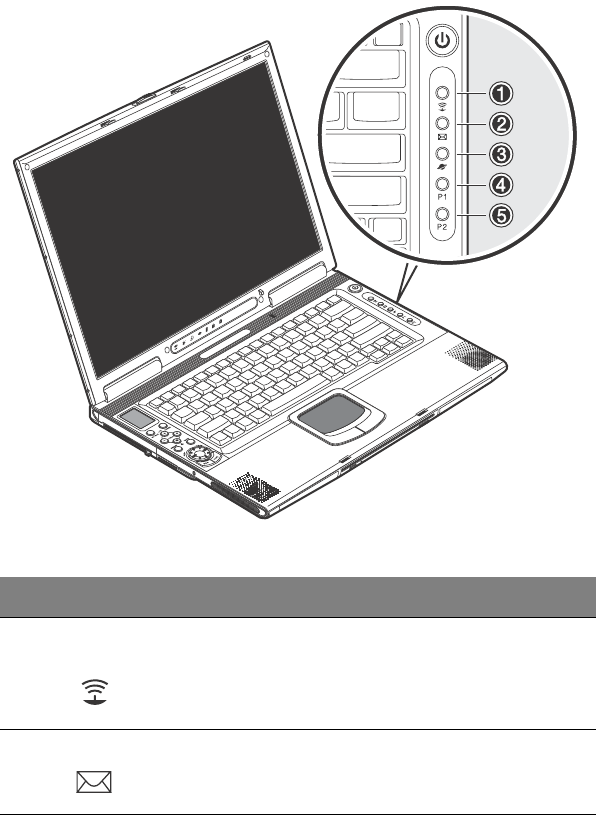
23
Launch keys
Located at the top of the keyboard are five launch keys used to launch frequently
used applications.
#Item Description
1 Wireless
communication
This button is used to enable or disable the Bluetooth/
Wireless LAN (optional) function.
2 Email The mail button is used to launch the email application.
AJC-e.book Page 23 Wednesday, September 3, 2003 1:48 PM
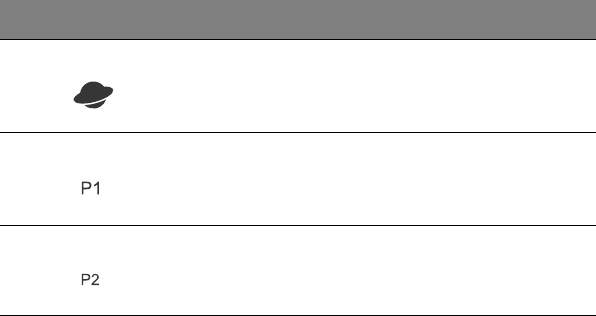
1 Getting familiar with your computer24
3 Internet browser By default, is used to launch your internet browser.
4 P1 This button is user-programmable.
5 P2 This button is user-programmable.
#Item Description
AJC-e.book Page 24 Wednesday, September 3, 2003 1:48 PM
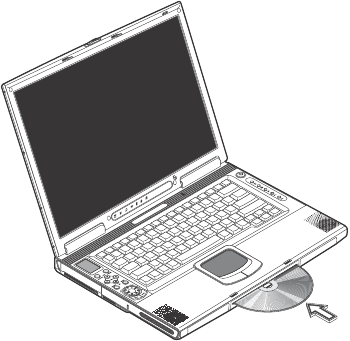
25
Storage
This computer supplies you with the following media storage:
• High-capacity Enhanced-IDE hard disk
• Slot-loading DVD/CD-RW combo drive
• Secure Digital (SD) slot
• Optional external USB 3.5-inch floppy drive
• Optional second hard disk module
Hard disk
The high-capacity hard disk is the answer to your storage needs. This is where
your programs and data are stored.
Optical drive
A high-speed optical drive (DVD/CD-RW combo drive) gives you portable
multimedia access and at the same time lets you burn your data onto a CD
recordable disc.
Inserting the disc
This computer features a slot-loading optical drive. To insert a disc into the optical
drive, gently push the disc into the slot and the drive will lock the disc in place and
pull it inside.
AJC-e.book Page 25 Wednesday, September 3, 2003 1:48 PM
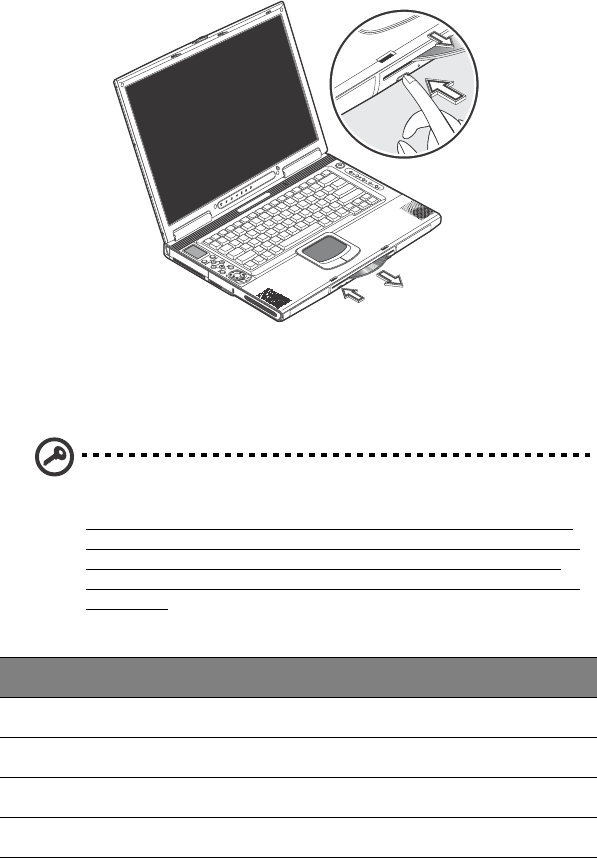
1 Getting familiar with your computer26
Ejecting the disc
To eject the disc from the slot, press the eject button and wait for the drive to eject
the disc.
Playing DVD movies
To play DVD movies in your computer, just insert the DVD disc into the drive and
the DVD movie will automatically play after a few seconds.
Important! When you launch the DVD player for the first time, the program
asks you to input the region code. DVD discs are divided into 6 regions.
Once your DVD drive is set to a region code, it will play DVD discs of that
region only. You can set the region code a maximum of five times (including
the first time), after which the last region code set will remain permanent.
Recovering your hard disk does not reset the number of times the region code
has been set. Refer to the table below for DVD movie region code
information.
Region code Country or region
1 U.S.A., Canada
2 Europe, Middle East, South Africa, Japan
3 Southeast Asia, Taiwan, Korea (South)
4 Latin America, Australia, New Zealand
AJC-e.book Page 26 Wednesday, September 3, 2003 1:48 PM

27
Note: To change the region code, insert a DVD movie of a different region
into the DVD-ROM drive. Please refer to the online help for more
information.
5 Former U.S.S.R., parts of Africa, India
6 People's Republic of China
Region code Country or region
AJC-e.book Page 27 Wednesday, September 3, 2003 1:48 PM
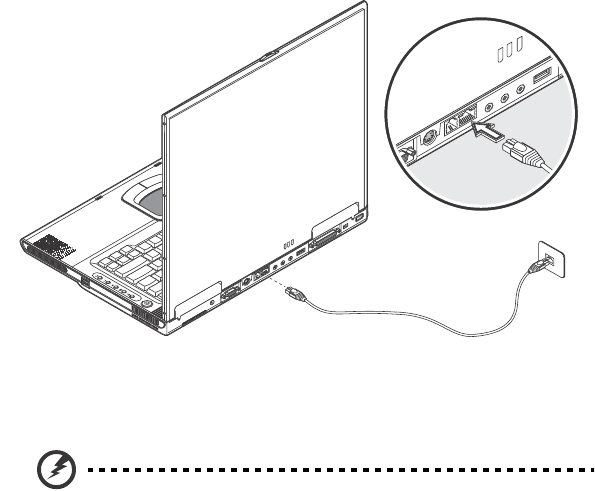
1 Getting familiar with your computer28
Connectivity options
The computer has built-in features for connecting to a network and communicating
with other computers.
Ethernet and LAN
The built-in network feature allows you to connect your computer to an Ethernet-
based (10/100 Mbps) network.
To use the network feature, connect an Ethernet cable from the network jack on the
rear of the computer to a network jack or hub on your network.
Fax/data modem
The computer has a built-in fax/data modem (available in select countries).
Warning: This modem port is not compatible with digital phone lines.
Plugging this modem into a digital phone line will damage the modem.
AJC-e.book Page 28 Wednesday, September 3, 2003 1:48 PM
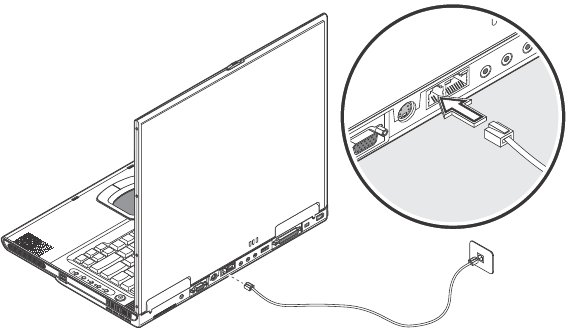
29
To use the fax/data modem port, connect a phone cable from the modem port to a
telephone jack.
AJC-e.book Page 29 Wednesday, September 3, 2003 1:48 PM
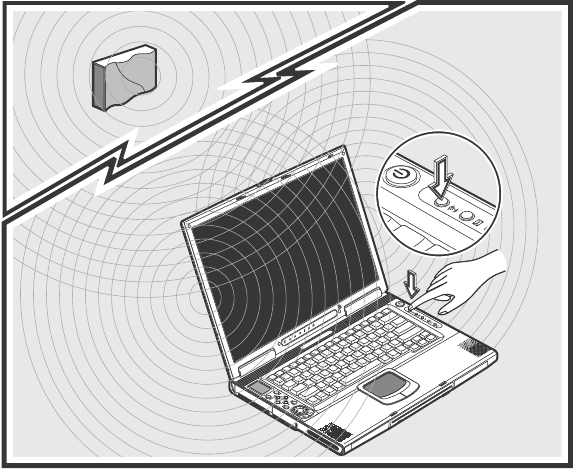
1 Getting familiar with your computer30
Optional wireless communication
This computer has optional wireless communication feature built-in. This feature
allows you to communicate with other wireless communication devices.
You can manually turn off your wireless communication feature.
AJC-e.book Page 30 Wednesday, September 3, 2003 1:48 PM